
The internet is one of the greatest inventions in the history of mankind. It allows us to share the knowledge of the world and to communicate throughout that world. It’s allowed life saving surgery to be performed in remote locations and has brought the truth of freedom to repressed countries. It probably is the single biggest technological and social advancement in the history of man.
So why do so many of us use it to argue endlessly with people we don’t know? The internet has also given a platform to some of the worst human behavior and that is exploited at every level.
My point is, don’t believe everything you read on social media. Take shooting for example. In the last few years, it seems as if everyone but me has a rifle that will shoot ½-inch groups at 1,000 yards. (FYI: According to the same internet, the world record for a five shot group at 1,000 yards is 1.068 inches.) Yet so many on Facebook claim to have an out-of-the-box rifle that shoots better than the world record by half. They post photos of the targets as proof. Often, they have odd scorch marks on them.

I have been writing about guns full time for almost 40 years. Much of my work is testing and writing about new rifles. Part of any article about a new rifle is a formal range test where I shoot several groups from a benchrest at a measured 100 yards. For many years, the data has been entered into a database, so I have a pretty good idea of what to expect from a new rifle in terms of accuracy.
There is little doubt that new factory-produced rifles have gotten much more accurate. That is often attributed to new manufacturing techniques using computer controlled machines, which is true, as far as it goes. The bigger reason is market competition.
Let’s look at triggers as an illustration. When I first started testing guns in the 80s, the triggers on factory rifles were universally horrible. I argued with a lot of rifle manufacturing executives and engineers that they didn’t have to be, but they all ignored me.
Then Savage Arms came out with the AccuTrigger in 2002. (I was a beta tester for this trigger and told them I thought it was too fragile and complicated for hunters. Boy, did I blow that one!) This trigger proved that a factory rifle can have a good trigger pull and still be safe. Soon enough, every other rifle manufacturer was shipping guns with better triggers. Even those companies who mocked me for suggesting such a thing was possible.

Fast forward to a few years ago and we saw the same market-driven competition apply to rifle accuracy. The interest in long-range shooting spiked rather quickly, driving more shooters to demand better shooting rifles. Accuracy had been improving slowly over the years, but this was a catalyst to drive the trend even faster.
When Ruger came out with the Ruger Precision Rifle—with a street price under $1,000—shooting groups well under 1 MOA, the industry was changed. Every rifle manufacturer of note followed with an affordable precision rifle. Some didn’t get the memo about accuracy and tried to slip by with the old standard; they didn’t last long. If you want to play in today’s market, your rifle has to shoot factory loaded ammo at sub-MOA. The best of them will shoot close to 0.5 MOA.

That accuracy trickled down to hunting rifles, and I’m seeing more and more that astound me at the shooting range. To keep up with the rifles and market demands, ammo had to improve, as well. Long-range shooting and long-range hunting have raised the bar—now even ammo must work at precision shooting levels.
How good? I tested the Federal Edge ammo in a .308 rifle I built. This hunting ammo averaged .58-inch at 100 yards. I tested the Barnes Vor-Tx LR last year for American Hunter. I used three hunting rifles, a Mossberg Patriot 6.5 Creedmoor, Weatherby .270 Winchester and a custom .300 Winchester rifle that I built. The average for the three rifles was .74-inch. The worst group was 1-inch and the best was .55-inch. The difference between the rifle averages was only .07-inch, less than a tenth of an inch—accurate and consistent.

Factory match ammo is even better. Hornady’s 6mm Creedmoor factory ammo has produced multiple .25-inch groups from a precision rifle I built.
As for factory rifles, let’s look at what’s changed. I went into my database and randomly selected six bolt-action rifles I tested in 2001. I simply picked them as they came up while I scrolled through the database with no effort to pick and choose. These were all tested to the NRA protocol of five, five-shot groups with each of three different ammo products. The average of 70 five-shot groups at 100 yards was 1.9 inches. Back then, this was considered acceptable accuracy. Today, we demand groups half that size. Out of those six rifles and 18 different ammo products, one produced a sub-inch average group size at .96-inch. The rifle was a Browning A-Bolt in .300 WSM. The ammo was Winchester 180-grain Fail Safe, a load that is no longer produced.

I also picked eight factory made bolt-action rifles tested in the past few years. Again, no attempt to cherry pick, just chose them at random. They range from an ultra-light hunting rifle through precision long-range rifles. The average for 85, five-shot groups at 100 yards is .9 inches. If I am doing my math correctly, that’s .86 MOA. When I remove the ultra-light rifle and the precision rifles and just look at the three “average” hunting rifles, the average group size is .816 inches. To say that’s a huge improvement in hunting rifle and ammo accuracy in the past two decades fails to capture the magnitude of the change.
That level of accuracy today would astound your grandfathers. If you had told the great gun guys of the early 20th century that factory rifles would be this accurate, they would have laughed at you. We truly have come a long way. But, .5-inch 1,000 yard groups? That is still an internet fantasy. At least for now.




































